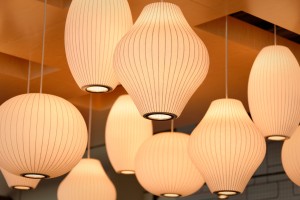
 –By Swati Parvatiyar*
–By Swati Parvatiyar*
Importance of light in interiors
Lighting creates great impact in interiors. While on one hand it sets the mood of a room, on the other hand it also creates a perception on the size of the room. It can create the illusion of space and simultaneously help highlighting the décor. To understand it better, let us first talk of colours. We know that darker colours make a room look cramped and heavy. We also know that light colours do just the opposite. A light coloured wall creates an illusion of space because of the light reflected off of the wall’s surface.

There are different types of lighting. They could enhance illusion by further illuminating the wall, or do the opposite.
Hence it is important to clearly understand the purpose that lighting is required to serve. Otherwise it is simply a waste of electricity. For example chandeliers are used in large rooms, open foyers. This is because of their centrally themed placement that provides excellent illumination.

Be clear about what style of lighting you want. You can opt for the best directional or luminescent type for the setting. Opt for task-specific lighting for desks and other work areas where functionality is more important than overall room illumination.

Directional lighting, for example a track lighting, can soften the wall colours. It is the perfect example of positional lighting. Hung from the ceiling, the adjustable necks and lamps can be pointed at specific objects such as wall paintings, vase of flowers on an entryway table or the bar top or kitchen island. Consider mounting them on the walls, also. Some photo and mirror frames also have built-in lighting to highlight specific areas on a wall.

Similarly, recessed lighting can be used in floors and ceilings to create vertical beams of light to illuminate the floors with its soft, downward glow. This is unlike the lights hung from the center of the room, which provide ambient illumination, or wall lighting. Wall lights are used to add length and size, visually, to an entryway hall.
All these lighting styles determine the light or dark appearance of a coloured section with defined level of accuracy.
Also read: Know the Interiors – Part 2

Remember that interiors are all about placement and size along with colour selection, and furniture. While right design is an underlying factor, lighting plays the most important role to define the ambience of the place. The lighting in a room either provides illumination for the entirety of the room, or it highlights very specific elements.

A right mix of available natural light with artificial lighting is crucial because the elements that come together when the right lighting is achieved, has the potential of seamlessly transforming a room into a combination of functionality and style. For a darker room, full-spectrum natural light can be a better choice.

Natural lighting is also preferred because it shows off colours better and adds to the visual space of a room by bouncing off reflective surfaces more effectively than artificial lighting. One may also consider skylights or large windows for more natural light. In case it is not possible that one may alternatively use sheer drapes and curtains to allow the maximum amount of light from windows.

But both natural as well as artificial lighting help creating the illusion of space. They need to be used effectively to play with available space. As it is, without enough light a room will look cramped. In such a case even close-proximity furniture arrangements make the room look even more cramped. So the right mix is important. No doubt lighting is a style statement.
*Swati Parvatiyar is the Head of Department of Interior Designs at Jagannath Institute of Management Sciences (JIMS), Vasant Kunj-II, which offers one of the best interior design courses in New Delhi
Article courtesy jimssouthdelhi.com






Good and informative